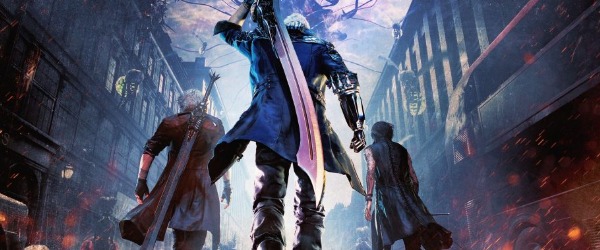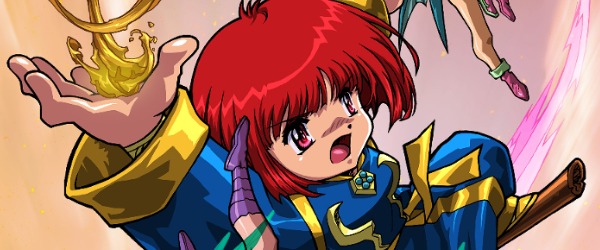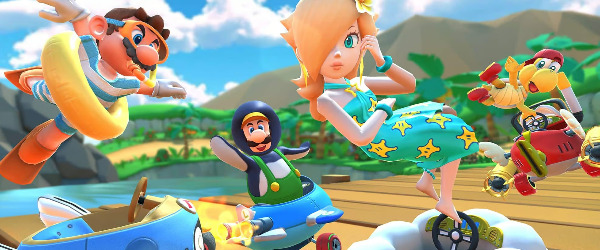
A Look Back at the Warriors Series on PlayStation Handhelds - Article
by Adam Cartwright , posted on 15 June 2019 / 4,299 ViewsIn 2000, with the release of Dynasty Warriors 2, Japanese developer Omega Force birthed a new genre of games that would become the company's bread and butter going forward – a mix of hack ‘n’ slash and tactical action often referred to as Musou (or Warriors by western audiences). They involve traversing huge battlefields and slashing through thousands of enemies to capture bases, relying on spectacle and a large array of playable characters to appeal to fans.
The Warriors series started out steeped in historical lore – Dynasty Warriors is based on the ancient Chinese text Romance of the Three Kingdoms, while Samurai Warriors is based on the warring states period of Japanese history. In recent years this has expanded to include a number of anime franchise, starting with Gundam and following on with Attack on Titan, Berserk, Fist of the North Star, and One Piece; each one tweaking the base formula around the IP to produce some interesting results.
On Sony’s line of handhelds, the Warriors games started with a bang with the launch of PSP in 2004 and continued strong until Warriors All-Stars in 2017, so if you’re looking for a portable fix of Musou action you can’t go far wrong with the line-up that’s available on Vita!
Portable Warriors
Omega Force was one of the first companies to show up for the PSP’s launch in Japan in 2004, with a bespoke Warriors title, and this would begin an ongoing love affair with the platform over the next decade.

That first game was Dynasty Warriors, a built-for-the-hardware new entry that took the gameplay (and some of the assets) from the console version but customised them for portable play. For example, rather than the large-scale battlefields seen in the home console entries that could take anywhere up to an hour to beat, the PSP version offered smaller interconnected grids which would take around 5-10 minutes each, allowing smaller chunks of play but also introducing some tactical thinking as you must decide where to move next.
Despite the graphical and performance hit that was taken in the move to a handheld, it proved to be a success. Western reviews seemed relatively positive (at least for the series) and in Japan the game sold nearly 300k copies. It was followed by a direct sequel - Dynasty Warriors Vol 2 - in 2006, which kept much of the same features, but was generally a lot less successful both critically and commercially, leading to Koei-Tecmo shifting gear for its next handheld entry.

Samurai Warriors: State of War was the first PSP take on the Japan-inspired Warriors series and was revealed as a port of the very first Samurai Warriors game, although it became apparent that like the two Dynasty Warriors titles before it, things had been changed slightly for handheld play. Grid-based battles, tactical play and toned-down graphics were all present and reviews seemed very similar to what had come before, but sales were notably down in Japan (100k).
Thankfully, it wouldn’t be long until Omega Force would put the effort in to bringing the full Warriors experience to PSP.
Full Portable Warriors
In 2008, we got our first taste of what a fully-fledged handheld Warriors experience could be with the release of Warriors Orochi.

Pretty much a direct port of the PS2 and Xbox 360 game and featuring the large-scale battlefields the series was known for, only a few concessions were evident to cope with the PSP’s weaker hardware (graphics and sound effects were toned down and cutscenes were shown in 2D animated stills rather than real-time). Again, it seemed to be a big success for Koei-Tecmo as it followed this up with a port of Warriors Orochi 2 (also in 2008), which was similarly well-received for its ability to offer a full portable experience on the go. The second game sold an impressive 200k in Japan compared to 150k for the first.
Omega Force would continue to deliver down-ports of its home console titles for the next few years – Dynasty Warriors 6 Special, Dynasty Warriors 6 Empires, Dynasty Warriors 7 Special, Samurai Warriors 3 Z Special, and Warriors Orochi 3 Special all landed between 2009 and 2012, cementing PSP’s legacy as a brilliant portable Warriors machine. Many of the ports saw only minor cut-backs similar to Warriors Orochi 1 & 2, making them a great way to experience the series.

Unfortunately, for whatever reason these games never hit western shores and remained Japan-only, meaning unless you were keen on importing you’d have to pick up one of the earlier titles, which was quite disappointing.
New Ideas and New Hardware
Over the years, many reviewers have commented that the Warriors series has only taken small steps to move its core gameplay formula forward, leading to a number of repetitive entries in a row. That definitely wasn’t the case when Dynasty Warriors: Strikeforce released in 2009 though and this entry ultimately turned the series on its head.

Originally a PSP exclusive, Strikeforce brought in new elements such as aerial combat, ad-hoc multiplayer, and a home base from which you select missions in a move that was clearly inspired by Monster Hunter‘s runaway success on Sony’s handheld. It proved to be a winning formula in Japan, where the game sold more than 350k copies, making it the best-selling handheld Warriors title to date and quickly spawned a sequel which released in 2010 (and undoubtedly led to the ideas being developed in a different manner in Omega Force's Toukiden).
Unfortunately, its overseas performance was less impressive – the game was overshadowed by releases on the PS3 and Xbox 360, so the PSP version received little attention despite decent reviews. The fact it relied on ad-hoc multiplayer compared to the home console version’s online multiplayer likely didn’t help matters either, due to the complexity in setting this up. As a result, the game’s sequel (Dynasty Warriors: Strikeforce 2) remained Japan-only, and became yet another addition to the growing pile of titles you would need to import if you were a handheld fan of the series.

Thankfully, Omega Force took the momentum from Strikeforce and turned it into something positive for the first release on Sony’s newest handheld. Dynasty Warriors Next used the gameplay from Dynasty Warriors 7 as a base but combined a load of different ideas to make a truly new experience. It threw in things like a conquest mode, where you take over various different areas on a map (very similar to the gameplay found in the Empires titles), plus touch-screen battles, customisable characters, and a ‘coalition’ mode for local multiplayer. Graphically, the game was also a massive step up over its PSP predecessors and was one of the prettiest of the Vita launch games.
While it didn’t get everything right, reviewers (like myself) found plenty to love, but Japanese sales were weak at just 91k. Likely due to its lukewarm performance, the next step for the evolution of the franchise on handhelds seemed to be a return to what had come before – cut-down ports of home console entries.
The Warriors Porting Era
Despite seemingly taking steps to evolve the franchise on handhelds with Strikeforce and Next, Omega Force returned to ports for the next few years on Vita. Thankfully, these were the full experience that offered a drastic step-up over their PSP predecessors.

The first of these was Warriors Orochi 3 Ultimate, amusingly a third re-release of the original title that had also been ported to PSP in 2012. Ultimate added a host of new playable characters alongside two new story modes, making it the best way to play an already well-received entry in the franchise. It launched alongside a PS3 version late in 2013 in Japan (a year later in the west), to fairly positive reviews focusing on the heaps of content it contained, despite the technical downgrade it had received.
Also available during 2013 was Dynasty Warriors 8: Xtreme Legends, another expanded re-release, but this time of a game that hadn’t come to handhelds before (Dynasty Warriors 8). The Xtreme Legends version brought with it new playable characters, stories, and modes – although it obviously hadn’t been a smooth porting process to handheld as the game suffered from noticeable texture downgrades and framerate issues. It seemed Omega Force still needed some time to adjust to the hardware.

Thankfully it wouldn’t take long for them to improve their efforts. Samurai Warriors 4 was the latest entry in the sub-series that launched simultaneously across PS3 and Vita, and it seems that significant efforts were put into the handheld version, which ran smoothly and looked gorgeous. It was rewarded with impressive sales in Japan (110k) and was followed by two sequels – Samurai Warriors 4-IIand Samurai Warriors 4 Empires, both of which built on the gameplay base of the original and expanded it in enjoyable ways.
Aside from these, we also saw Dynasty Warriors 8 Empires (a tactical take on the Warriors formula that encourages strategic thinking over hack ‘n’ slash action), Samurai Warriors: Chronicles 3 (sequel to a previously 3DS-only game that focuses on individual character stories over large-scale narratives), and Samurai Warriors: Spirit of Sanada (a semi-open-world adventure starring Sanada Maru). All offered different takes on the base formula, although sadly only the former two were made available in English.
Licensed Warriors
During the PS2 era, the Warriors games were a sales force to be reckoned with in Japan, with multiple entries (including Dynasty Warriors 3 and Samurai Warriors) clearing 1 million copies sold. Over time, enthusiasm in the franchise began to wane and Koei-Tecmo offset declining sales by working with other popular IPs (particularly anime series) to produce crossovers, many of which flourished on Vita.

The first of these to be made available on the handheld was One Piece Pirate Warriors 2 in 2013, based on the massive-in-Japan One Piece anime/manga series. Following the story of the straw hat pirates in an original story set in the New World, it proved to be hugely successful in the land of the rising sun, shifting 410k copies alongside a PS3 version, although frustratingly only the home console port received a western release. Thankfully this was rectified in the 2015 sequel One Piece Pirate Warriors 3, which proved to be an even bigger seller domestically (155k on Vita alone) and came west on the handheld later that year.
Also available in 2013 was Dynasty Warriors Gundam Reborn, based on Japan’s favourite mech action franchise. Despite being arguably the best-looking and best-performing Warriors title available on Sony’s handheld, it suffered a similar fate to One Piece Pirate Warriors 2 in that only the PS3 port released in the west. Although it’s an easy-to-play import, the lack of an English option was a disappointing omission in an otherwise stellar title – something that would become a running theme for the series on Vita.

Over the next couple of years, Omega Force decided to skip handhelds for its Musou crossover titles – things like Arslan and Bladestorm only targeted home consoles for whatever reason. Thankfully that was rectified in 2016 with Attack on Titan: Wings of Freedom, a brilliant take on the hugely popular dystopian series that mixed large-scale battlefields with some absolutely liberating movement mechanics. It was popular enough (700k worldwide sales) to spawn a sequel two years later (Attack on Titan 2) but sadly this was another one where the Vita port was only available in Japan (at least this time around, we got the first release in English, even if it was digital-only).
One last anime crossover released in 2017 – Berserk and the Band of the Hawk – which provided an interesting interpretation of the dark and bloody IP and proved to be a good fit with the Musou formula, although reviews noted that the content became repetitive rather too quickly.
Experimental Warriors
Over the years, developer Omega Force has experimented repeatedly with its core Warriors formula, sometimes only tweaking minor elements, other times overhauling nearly everything about them. Again, Vita was home to a number of these, although whether any of them were truly successful is up for debate!

One such example is Dynasty Warriors: Godseekers, a turn-based tactical RPG that re-tells the events of the Romance of the Three Kingdoms saga in a brand new format (or at least, one not done since the PS2’s Dynasty Warriors Tactics). It wasn’t a particularly well-received entry and seemed to sell poorly, suggesting that at least for the time being we won’t be seeing any other spin-offs like this.
Another gamble the developer took was shifting away from the Warriors Orochi franchise with a new game named Warriors All-Stars. Orochi had started as a crossover between Dynasty Warriors and Samurai Warriors but quickly expanded to include characters from other series like Atelier, Dead or Alive and SoulCalibur, while All-Stars was birthed on the idea of being a crossover between all of Koei-Tecmo’s series. It meant that little known franchises such as Deception, Harukana Toki de Naka and Opoona were represented, but thanks to the small roster and questionable framerate (particularly on Vita) it was a poor seller and one-off experiment.

A final mention should go out to Dragon Quest Heroes II, which doesn’t technically fall under the Warriors umbrella although it was developed by Omega Force and contains a number of hack ‘n’ slash gameplay similarities (and it’s definitely more of an RPG than anything else). The game sold absolute gangbusters in Japan (235k on Vita alone) but, as with so many games in this article, it sadly didn’t come west on the handheld – only on PS4 & PC (even the Nintendo Switch port hasn't found its way overseas).
And speaking of Switch, it seems Nintendo's hybrid console is providing a new home for portable Warriors, as many of these games have been ported to it for the Japanese market, alongside new entries (such as Warriors Orochi 4) being created specifically for the hardware. It's nice to see that there's a place for full-fledged entries on the go well into the future.
Conclusion
Beating even the LEGO franchise in terms of the amount of entries that are available on Vita, the Warriors series has certainly embedded itself as a central part of the handheld’s library over the last 7 years. While arguments can be made that the central gameplay has failed to evolve over time, leading to a lot of repetition between entries, and that even when it does try to evolve the results are disappointing (look no further than on PS4 for proof of that), there are lots of players like myself out there that still love what’s on offer.
It’s certainly interesting to see how the series has evolved from the first handheld entries, which focused on small-scale areas and tactical movement, to the latest Vita versions which distilled the full-scale battlefields and console experience down into a portable form – but whatever your preference, there’s plenty here to sink your teeth into, making Vita a fantastic place to get started with Warriors!

















































